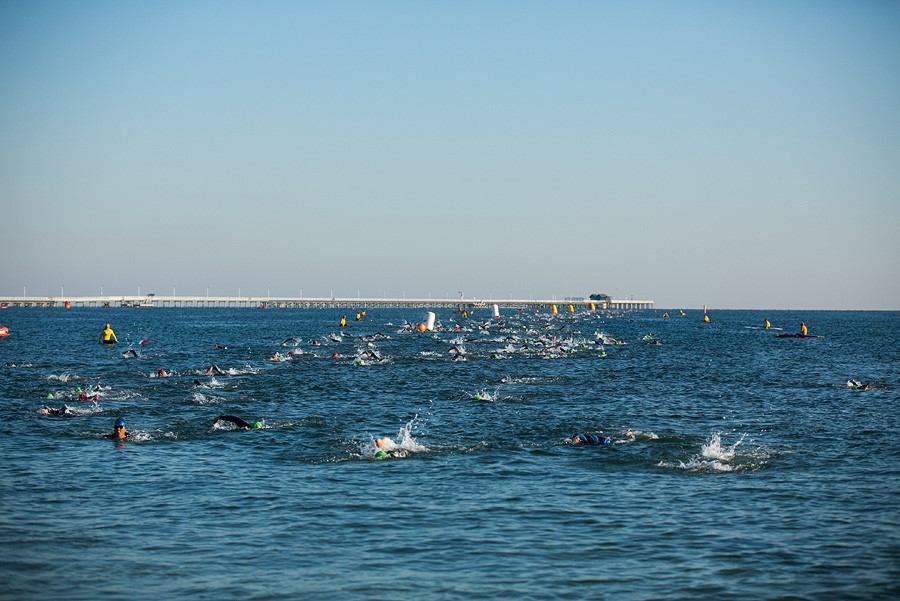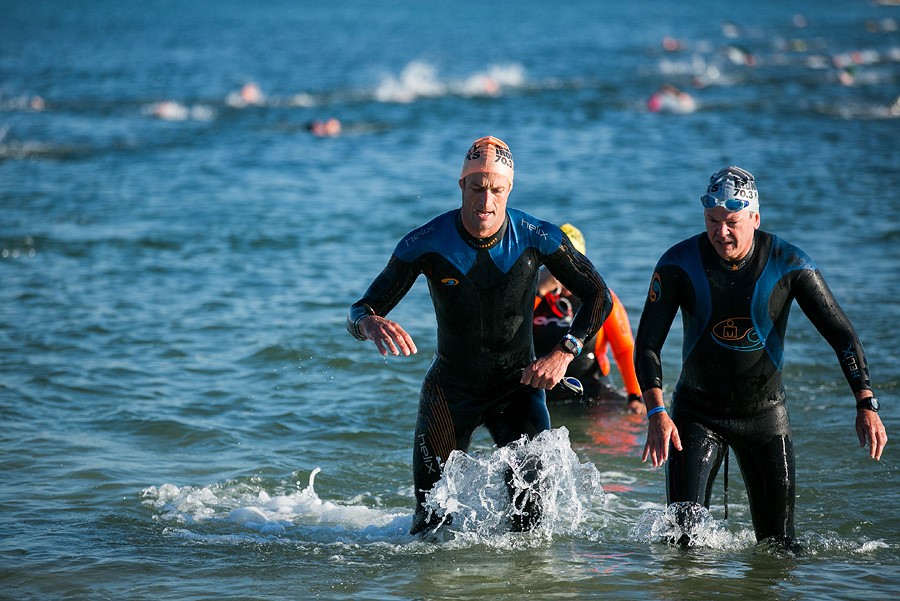
31 Jan The Swim
The Swim
(By Kate Bevilaqua and Guy Crawford)
For most of us when race day arrives it means we going to be moving from the comforts of our 25 or 50 metre pool, and swimming in the open water. If you are living in Asia then there is also a good chance it’s going to be a non-wetsuit swim.
So how do we deal with our anxiety or fear when it comes to racing and training in the open water?
Here are a few techniques that have helped us in the past.
- Practice: We spend hours biking and running and often we’ll do cycling or running time trial’s to simulate race day effort. BUT seldom do we practice getting in the “washing machine” that is a race day swim start. We know it’s not practical to go to the open water all the time. But you can practice a lot of these things in the pool. Share a lane with other swimmers where you’ll be forced to make contact, and swim side-by-side to become more comfortable.
It may sound a little crazy BUT mimicking the chaos of a swim start in the pool can help you realise you’ll be ok in the open water. More often than not, it’s not the open water that causes the anxiety/loss of breath BUT the swimming in close proximity to other people.
Practicing these skills along with swimming in the open water more regularly will make a difference.
- Breathing and pacing: Before the race/swim start you are naturally on edge. Your heart rate is elevated and you are nervous (and excited!) for the day ahead. When the starters gun goes off you put your face in the water and start swimming. There are two things you should be focusing on
- Exhaling: Instead of holding your breath as soon as your face is in the water you should be exhaling a steady stream of air. This helps when you go to take a breath and instead of trying to exhale and inhale in the split second your mouth is out of the water you have plenty of time to inhale only. This breathing method limits the chances of hyperventilating and is especially important to focus on during the start of a race.
- Pacing: During the start of a race your nerves can get the better of you and you may start TOO HARD. If you avoid sprinting the first 100 meters of the swim not only will you have a better all-round swim, but you will feel better and have less anxiety/breathing issues. Experienced swimmers can swim the first 100-300m fast and then settle back into a steady pace. Don’t get sucked into thinking that will work for you. Most of these guys and girls come from a swimming background and have practiced the things we are talking about here a lot. In time, as your swimming and confidence improves you’ll be able to push harder. But for now building into a swim is the key for success.
- Warm up: It’s important to get in the water before the start. Being familiar with the beach, water temp, course, sun, wind direction and chop are great things to know before you start the race. Knowing these things will ease your mind and leave you feeling confident about the swim ahead.
- Starting Position: Avoid the middle of the pack. The middle of the pack is where “the washing machine” is at its worst. You don’t want to get caught up in a sea of human limbs. So where to start?
- To either the left or right of the start line. There may still be people around you but there will be less than if you were centered. This is a great option if you want to be competitive throughout the race, but struggle with the swim starts. Do you have a favourite breathing side? Let’s say you like to breathe to your LEFT. Then start to the right of the start line/main group of swimmers. This way whenever you take a breath you’ll be looking at the majority of the swimmers. Thus keeping you swimming in a straight line and also help avoid swimming into a mass of people.
- Start near the back and wait a few seconds after the starters gun goes. You won’t lose much time, but you’ll keep out of the washing machine and be able to settle into your rhythm straight away.
- Equipment: The simple things.
- Make sure your goggles do NOT fog or leak. Not being able to see where you are going is never fun and doesn’t help that anxious feeling.
- Swimwear: Try to avoid anything that doesn’t fit snug to the body. Things like pockets or loose fitting tops are like anchors in the water. The best thing to do is use a swim skin in Non wetsuit races or a one piece tri suit that fits snugly to the body without causing that tight chested feeling. While the material in a swim skin is textile it still makes you feel like you’re sitting higher in the water than a standard Tri Suit. Use a wetsuit (that you have worn before and practiced in) for all swims where you are allowed to. We practice in the pool using wetsuits every few weeks. So there are no surprises on race day.
- What happens if I still panic? Stay Calm. Move out to the side. Turn and float on your back. Do some relaxed breast-stroke. A lot of people think you have to swim freestyle in the race. This isn’t true. You can do breaststroke if you need to. Take your time, re-group, focus on your breathing and think “one swim buoy at a time”. Focusing on small goals along the way is far better than focusing on swimming the entire course. 100m at a time!
Hopefully we’ve helped you understand how to tackle the open water. Preparation and practice are the key!
If we’ve missed something, feel free to send us a message and we’ll do our best to turn you into the strong confident open water swimmer you can be.
Cheers
Guy and Kate.


